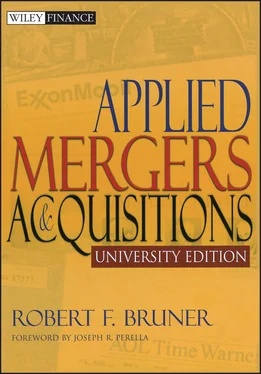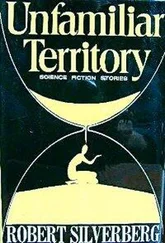My reading of the studies leads me to choose “Does pay, but….” I take the economists’ perspective that an investment is deemed to “pay” if it earns at least the opportunity cost of capital. Abstracting from the studies, the majority of transactions meets this test for targets, bidders, and the combined firms. But the buyer in M&A transactions must prepare to be disappointed. The distribution of announcement returns is wide and the mean is close to zero. There is no free lunch. The negative performance postmerger (see Exhibit 3.6) is troubling, but absent a rigorous strong-form test, we must await further research to see whether the poor performance is tied to the mergers or to more general phenomena in markets. In the interim, shareholders of both target and buyer firms should be cautious. The outcomes of most transactions are hardly consistent with optimistic expectations. Synergies, efficiencies, and value-creating growth seem hard to obtain. It is in this sense that deal doers’ reach exceeds their grasp.
Based on the mass of research, my advice to the business practitioner is to be coldly realistic about the benefits of acquisition. Structure your deals very carefully. Particularly avoid overpaying. Have the discipline to walk away from uneconomic deals. Work very hard to achieve the economic gains you hypothesized. Take nothing for granted. M&A is no money machine, and may well not offer the major career-building event you wanted. The only solace is that you could say the same about virtually any other form of corporate investment; on balance, your shareholders will earn a going rate of return on M&A activity. Given the uncertainties in M&A as elsewhere, one must remember the ancient advice, caveat emptor (buyer beware).
This chapter is an expanded and updated version of an article by the same name and author (Bruner 2002) that appeared in the Journal of Applied Finance . It appears here by the kind permission of the editors, Ali Fatemi and Keith Howe.
1 1. Grubb and Lamb (2000), pages 9, 10, 12, and 14.
2 2. In England, the village commons was a field jointly used by villagers to graze their animals. Because the field was, in effect, held by all, no one individually looked out for the welfare of the social good. The problem of the commons was to prevent behavior (such as overgrazing by selfish villagers) that would harm the welfare of all.
3 3. The story is rather different for the Time-Warner shareholders, who wound up cushioning the collapse of the Internet bubble for the AOL shareholders.
4 4. In a memorable comment, Caves (1989) wrote, “This technique was a genuine innovation—theoretically well grounded, cheap to execute, and able to evade the problem of holding constant other factors that plague ex post studies of mergers’ effects. A better product, available at a lower price, naturally swept the intellectual marketplace.” ( Page 151)
5 5. Tests of significance also depend on sample size. The t values discussed here implicitly assume relatively large samples of observations, such as more than 100.
6 6. [(1.01)52 – 1] = 0.678.
7 7. See Dennis and McConnell (1986) and Billett, King, and Mauer (2003). Also, Maquieira, Megginson, and Nail (1998) report, “Apart from bidding firm stockholders in conglomerate mergers, all major classes of debt and equity securityholders of both bidders and targets either break even or experience significant wealth gains.” ( Page 30)
8 8. Meeks defines return on assets as pretax profits (after depreciation, but before tax) divided by the average of beginning and ending assets for the year. The key metric was RChange = RAfter – RBefore where RAfter and RBefore were measures of performance relative to the weighted average of returns of the buyer’s and target’s industries.
9 9. Ravenscraft and Scherer examine the performance between 1974 and 1977 of mergers that occurred from 1950 to 1977. In other words, the period under observation was not the same number of years after merger from one observation to the next.
10 10. Bradley, Desai, and Kim (1988) report that average announcement returns to bidders fell from 4.1 percent in the 1963 to 1968 period to –2.9 percent in the 1981–1984 period.
11 11. See Servaes, Lang, Stultz, and Walkling (1991), Harford (1999), and Jensen (1986).
12 12. Jensen and Ruback (1983) give a survey of returns in contested and friendly deals. Numerous studies report positive significant returns to bidders in hostile transactions: Asquith, Bruner, and Mullins (1987), Gregory (1997), Loughran and Vijh (1997), Rau and Vermaelen (1998), Lang, Stultz, and Walkling (1989), and Jarrell and Poulsen (1989). On the other hand, Healey, Palepu, and Ruback (1997) found that hostile deals were associated with insignificant improvements in cash flow returns, owing possibly to the payment of higher acquisition premiums.
13 13. Agrawal and Mandelker (1987) found that lower equity investment by managers in their own firms was associated with higher propensity to undertake variance-reducing acquisitions. You et al. (1986) found that announcement returns to bidders were lower (i.e., more negative), the lower the managers’ equity stake in the buyer firm.
14 14. Page 55, italics added.
15 15. Dennis Mueller (1979), page 307.
16 16. Jensen and Ruback (1983), page 5.
17 17. Weidenbaum and Vogt (1987), page 166.
18 18. Caves (1989), page 167.
19 19. Datta, Pinches, and Narayanan (1992), page 13.
PART Two Strategy and the Origination of Transaction Proposals
CHAPTER 4 M&A Activity
INTRODUCTION
History is a tough instructor. Though its lessons are sometimes obscure, their ramifications can be severe. And, more often than not, they prove to be vital in charting a course for the future. This is why any serious student of M&A should reflect on the past century of activity. This chapter highlights some of the competing explanations for the activity we observe over time. Though these explanations are not mutually exclusive, one of them yields useful insights for the practitioner. This explanation argues that M&A activity is not a result of random behavior by managers, but rather is motivated by deep forces of change at work in an economy. Thus, to understand the influence of those forces is to be able to anticipate opportunities and challenges in the transaction development process. This chapter sketches some practical implications of this view.
M&A ACTIVITY APPEARS IN WAVES
The point of departure in a study of M&A activity is to look at the aggregate activity over the long term: the past 100 years. There are two ways to consider deal activity: in terms of the number of transactions, and in terms of their aggregate dollar value. A focus on the number of transactions, in effect, gives equal weight to all deals—this is an implicit measure of breadth of M&A activity in the United States. Conversely, a focus on the dollar value of all transactions helps to distinguish those episodes dominated by large deals—this might be regarded to be a measure of depth or materiality of sizable deals.
Exhibit 4.1presents the history of M&A activity in terms of number of deals. Exhibit 4.2gives M&A activity in terms of constant dollar value. 1 In both exhibits, the data are presented on natural and logarithmic scales—the log scales help to highlight those periods when M&A activity jumped sharply in percentage terms, such as 1895 to 1900 and 1965 to 1970. Exhibit 4.3considers M&A activity relative to the size of the U.S. economy—this helps distinguish the materiality of successive periods of activity. Exhibit 4.4presents some notes for the reader on the sources for the data in the graphs.
Читать дальше












